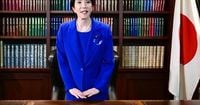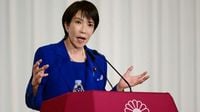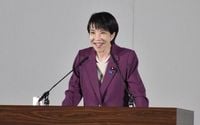Japan is on the cusp of a historic political moment as Sanae Takaichi, a 64-year-old hardline conservative and former Economic Security Minister, stands poised to become the country’s first female prime minister. Her ascent to the leadership of the long-ruling Liberal Democratic Party (LDP) on October 4, 2025, follows a period of political turbulence and sets the stage for a series of formidable challenges—both at home and abroad.
Takaichi’s victory in the LDP’s five-way leadership contest, culminating in a runoff against Shinjiro Koizumi, comes on the heels of the September resignation of Prime Minister Shigeru Ishiba. According to Financial Mirror, this marks the second leadership contest in a year, a direct consequence of the LDP’s back-to-back losses in national elections: the lower house in October 2024 and the upper house in July 2025. For the first time in seven decades, the LDP now leads a minority government in both houses of parliament, a reality that will shape Takaichi’s tenure from the outset.
Japan’s parliament is expected to convene around October 15, 2025, to formally elect the new prime minister. While the LDP lacks a majority in either house, it remains the largest party in the lower house, which ultimately decides the national leader. The opposition, meanwhile, is highly fragmented, giving Takaichi a clear—if not unchallenged—path to the premiership, as reported by the Associated Press and BBC.
But if Takaichi’s rise is historic, her road ahead is anything but smooth. She inherits a party divided between its conservative and liberal wings, facing the fallout of slush fund scandals, and grappling with public discontent over inflation and immigration. As Morningstar DBRS notes, “the new LDP leader has several challenges to address. On the domestic front, these include rising inflation, fallout of the slush fund scandal and growing unease over immigration.”
Takaichi’s politics are unapologetically hardline. A protégé of the late Shinzo Abe, she has championed “Abenomics”—a mix of monetary easing and fiscal spending—though she tempered her stance during the campaign. Her revisionist views of Japan’s wartime history and regular visits to the Yasukuni Shrine, a symbol of militarism for many in Asia, have drawn criticism both at home and abroad. These positions now threaten the LDP’s longstanding coalition with the Buddhist-backed centrist Komeito party, a partnership that has endured for 26 years.
The coalition’s future hangs in the balance. Komeito leader Tetsuo Saito delivered a pointed warning to Takaichi on October 4, saying his party has “big worry and concern” over her positions and would not stay in the coalition unless she shifts course. Komeito’s concerns center on her visits to the Yasukuni Shrine and her calls for stricter measures against Japan’s growing foreign population. According to AP, this rare public rebuke “shakes their 26-year-partnership.”
Faced with the prospect of losing Komeito, Takaichi must choose between sticking to her ideological guns or shifting toward the center—at the risk of alienating her conservative base. The LDP has floated the idea of expanding its coalition to include at least one of the key center-right opposition parties, but so far, efforts have been stymied by political infighting and skepticism.
In her first press conference as LDP leader on October 4, Takaichi emphasized the importance of strengthening the Japan-U.S. alliance, calling it “essential to her country’s diplomacy and security,” according to BBC. She also pledged to honor the tariffs and investment agreements struck between the previous Ishiba government and the Trump administration. Her foreign policy vision includes expanding trilateral partnerships with South Korea, Australia, and the Philippines, part of a broader push for a “Free and Open Indo-Pacific.”
Takaichi’s stance has already attracted international attention. On October 6, U.S. President Donald Trump congratulated her, declaring on social media, “Japan has just elected its first female Prime Minister, a highly respected person of great wisdom and strength. This is tremendous news for the incredible people of Japan. Congratulations to all!” Takaichi responded the next day, expressing her hope to “work together with President Trump to make our Japan-U.S. alliance even stronger & more prosperous, and to advance a Free and Open Indo-Pacific.”
Her early moves as party president have raised eyebrows. On October 7, she rewarded key supporters—especially those aligned with former prime minister and party kingmaker Taro Aso—with top party jobs. Aso, who played a decisive role in her leadership victory, is reportedly in line for a senior government post, and Takaichi is considering naming his close ally, Toshimitsu Motegi, a former foreign and trade minister, as Japan’s next top diplomat. Aso also met with a senior official from the opposition Democratic Party for the People on October 6 to discuss possible cooperation, according to AP.
Not all are pleased with Takaichi’s approach to appointments. She has suggested elevating several former Abe faction lawmakers implicated in slush fund scandals, despite mounting public criticism over the party’s lack of reform. Yoshihiko Noda, head of the largest opposition party, called such appointments “totally unthinkable.”
Economic policy is another tightrope. While Japan’s fiscal deficit has declined from the pandemic highs of 9% of GDP to 2.5% in 2024, Takaichi has signaled a willingness to pursue a slightly more expansionary fiscal stance in the near term. According to Morningstar DBRS, “Japan’s financial flexibility is high,” with the Bank of Japan holding close to 50% of outstanding bonds and the debt being almost entirely domestic. Still, higher government spending could see deficits edge higher, a potential flashpoint in a nation sensitive to fiscal discipline.
Externally, Takaichi must manage growing geopolitical tensions, particularly with China and the broader Asia-Pacific region. Her challenge will be to balance her conservative views—especially on wartime history and Taiwan—with the need to avoid aggravating relations with Beijing and Seoul, as highlighted by Financial Mirror.
With the LDP now a minority government, Takaichi will require support from opposition parties to pass legislation. Yet, the opposition remains splintered, and the LDP’s internal divisions between conservatives and liberals are likely to persist. Political watchers suggest that Takaichi’s reliance on party loyalty and patronage could either stabilize her leadership or deepen the rifts that have plagued the party in recent years.
As parliament prepares to convene and the formal vote for prime minister draws near, all eyes are on Takaichi. Her leadership marks an undeniable milestone for gender representation in Japanese politics, but the challenges she faces—coalition management, economic headwinds, diplomatic balancing acts, and internal party reform—promise a turbulent start to her tenure.
Japan’s first female prime minister will need every ounce of political acumen, resilience, and perhaps a touch of luck, to steer her party and her country through these uncharted waters.







